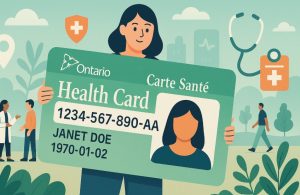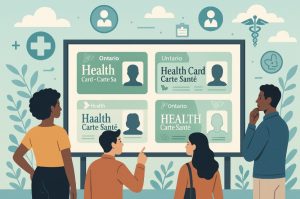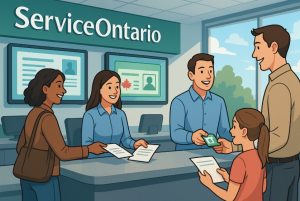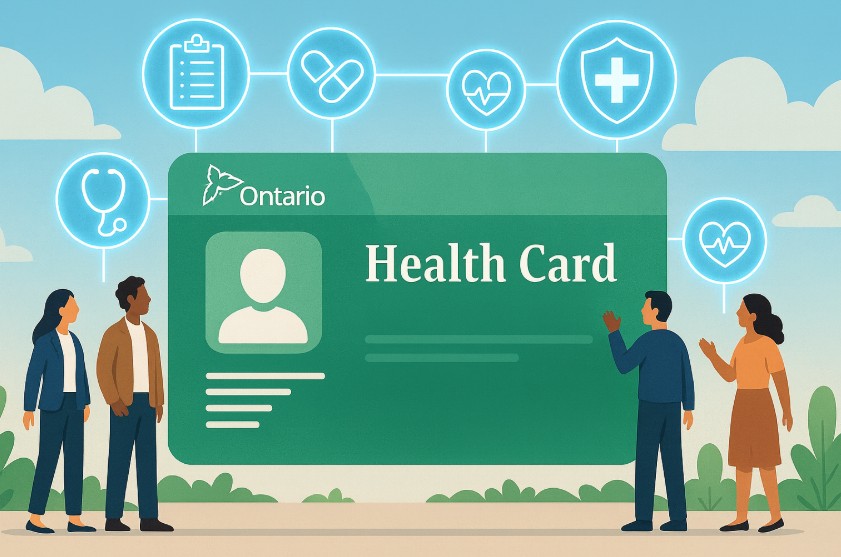When you look at your Ontario health card, you may notice a small detail that is often overlooked yet plays an important role in your access to healthcare. Right after your 10-digit health number, there is usually a one or two-letter code.
This is known as the health card version code. While it might seem like a simple combination of letters, the version code is a unique identifier that connects your card to the Ontario Health Insurance Plan (OHIP) system.
The version code ensures your health card is current, valid, and tied directly to your personal record. Without it, providers cannot always confirm your eligibility for services. In this blog, you will learn exactly what the version code is, why it matters, how to find it, and what to do if your card has issues.
What Exactly is a Health Card Version Code?

A health card version code is a randomly generated alphabetic identifier that usually contains one or two letters. It follows your 10-digit health number on the face of your Ontario health card.
While the number identifies you as an insured person in Ontario, the version code tracks the specific card you hold. This ensures the card being used has not expired, been reported stolen, or replaced.
The version code is important for more than just identification. It serves as a vital anti-fraud feature in the healthcare system. Each time you present your health card at a clinic or hospital, the system checks the version code against Ministry of Health records to verify whether your card is still valid.
Key points about the version code:
- Uniquely links your health card to your OHIP record
- Ensures the card is active and not outdated
- Confirms coverage for services under OHIP
- Helps providers avoid rejected claims
In short, the version code is not just random letters but a safeguard that helps keep Ontario’s healthcare system accurate, secure, and reliable.
Where Can You Find the Version Code on Your Ontario Health Card?
If you look at the front of your Ontario health card, you will see your 10-digit health number displayed clearly. Immediately after this number, there is usually a one or two-letter code.
This is your health card version code. On most cards, it is located directly next to the health number, and in some cases, it may also be found within the magnetic stripe on the back.
The version code appears on both modern photo cards and older red and white cards, though not every red and white card includes one.
To make it easier, here is a quick breakdown of where to find the version code based on card type:
| Health Card Version | Location of Version Code |
| Standard Photo Health Card | Front, next to 10-digit health number |
| Colour Enhanced Photo Health Card | Front, next to 10-digit health number |
| Black and White Photo Health Card | Front, next to 10-digit health number |
| Original Red and White Health Card | Some include version code next to the number, others do not |
Whenever you present your card, providers will use both the number and the version code to confirm coverage. This process prevents errors and ensures your information is always current.
Why is the Version Code Important for Your OHIP Coverage?
Your health card version code is not just a technical detail, it is an essential requirement for confirming your eligibility for OHIP-covered services. Each time you visit a doctor, clinic, or hospital, your card is validated, and the version code plays a major part in that process.
Here is why the version code matters:
- Verification of coverage: It ensures your card is active and that you remain eligible for healthcare services.
- Fraud prevention: The code helps protect against the misuse of lost, stolen, or expired cards.
- Billing accuracy: Healthcare providers rely on the correct version code to submit claims to OHIP without delays or rejections.
- Tracking card changes: Whenever a card is renewed, replaced, or updated, a new version code is generated to reflect the change.
Without a valid version code, even if your health number is correct, your claim may be rejected. This could delay your access to services or create billing issues. Ensuring you know your code and keeping it current helps maintain smooth healthcare access. In essence, the version code is the bridge between your identity as a patient and the administration of healthcare services in Ontario.
What Types of Ontario Health Cards Include a Version Code?

Ontario issues several types of health cards, and most of them feature a version code. Each variation reflects updates in design, security, and eligibility requirements. Understanding the differences will help you recognize how your version code appears and functions.
1. Standard Photo Health Card
The standard photo card was first introduced in 1995 to replace the older red and white card. It features a photograph, signature, name, and the health number with its version code printed on the front. It added stronger security features and introduced an expiry cycle to keep records updated.
2. Enhanced Colour Photo Health Card
Launched in 2007, this version added colour photography and additional security enhancements, including holograms and microprint. The version code is printed next to the 10-digit number on the front. This type of card is still valid and continues to circulate.
3. Black and White Photo Health Card
Between 2014 and 2016, Ontario issued a black and white version of the photo card. It still displayed the version code next to the health number. While these cards remain valid, they are gradually being phased out.
4. Red and White Health Card
The oldest card in circulation, the red and white version, does not always include a version code. Some types carry the code, while others rely only on the health number. Although still accepted if valid, these cards are slowly being replaced for security reasons.
| Card Type | Includes Version Code | Notes |
| Standard Photo | Yes | Introduced in 1995 |
| Enhanced Colour Photo | Yes | Security features added 2007 |
| Black & White Photo | Yes | Issued 2014 to 2016 |
| Red & White | Sometimes | Oldest still in circulation |
No matter which card you have, the presence or absence of the version code influences how it is validated for healthcare use.
How Do You Obtain or Update a Health Card Version Code?

Your health card version code changes whenever your card is renewed, replaced, or updated with new personal information. This ensures your record remains accurate and current.
When it change?
A new version code is issued when:
- Your card expires and is renewed
- You replace a lost or stolen card
- Your personal details change, such as a legal name or address update
- The Ministry issues a new style of health card
Documents Required
To obtain or renew a card with an updated version code, you must provide:
- Proof of identity (passport, birth certificate, or permanent resident card)
- Proof of Ontario residency (utility bill, driver’s licence, or rental agreement)
- Supporting documents for changes (marriage certificate, legal change of name)
In-Person vs. Online Application
- In-person: Visit a ServiceOntario centre where staff verify your documents and issue your updated card with a new version code.
- Online: Renew or update through the ServiceOntario website by submitting electronic copies of documents. The card with the updated code will be mailed to you.
| Process | How It Works | What You Get |
| Renewal | Apply before expiry date | New card with updated code |
| Replacement | For lost or stolen cards | Fresh card and version code |
| Personal Changes | Name, address, or info updates | Card reflecting changes |
By keeping your card current, you ensure your version code is always valid, preventing service interruptions.
How Can You Check if Your Health Card Version Code is Valid?
You may need to confirm whether your card is active before using healthcare services. Ontario provides two main ways to validate the status of your health card version code.
- Online validation: Through the ServiceOntario website, you can enter your health number and version code to instantly check if your card is valid. This method is fast, secure, and accessible anytime.
- Phone validation: You can also call ServiceOntario at 1-866-532-3161. The automated system guides you through the process to confirm whether your card and version code are current.
Healthcare providers also validate your card each time you present it. This protects both you and the system from errors and fraud. Checking your version code ensures you do not encounter service disruptions or rejected claims at the time of your medical visit.
How Do You Protect and Maintain Your Health Card Version Code?

Because your version code is tied to your personal health record, safeguarding it is crucial. Treat it with the same importance as other identifiers like your social insurance number.
Best practices include:
- Keep your card secure: Store it in a safe place and avoid carrying it unnecessarily.
- Share only when required: Provide your health card only to authorized providers or officials.
- Renew on time: Make sure your health card is renewed before the expiry date to avoid interruptions.
- Check validity regularly: Use online or phone services to confirm your card’s status.
- Report issues promptly: If your card is lost or stolen, report it immediately to prevent misuse.
By following these steps, you protect both your healthcare access and your personal identity. Regular maintenance of your health card details ensures your version code always remains valid.
What Happens if Your Ontario Health Card Has Issues?
Sometimes, health card problems arise that directly affect the version code. Knowing how to handle these situations helps you restore coverage quickly.
Common issues include:
- Lost or stolen cards: Report the issue to the Ministry of Health immediately. You will need to apply for a replacement card with a new version code.
- Expired cards: Renew before expiry to avoid interruptions. Renewal can be completed online or in person.
- Incorrect personal information: If your card shows outdated or wrong details, you must provide documents at a ServiceOntario centre to correct them and receive a new version code.
Healthcare providers validate your card at each visit, so these issues will be noticed if not addressed. Acting quickly ensures you remain eligible for OHIP-covered services without disruption.
Conclusion
Your health card version code might look like a minor detail, but it plays a vital role in the Ontario healthcare system. It keeps your information current, prevents fraud, and ensures your access to OHIP-covered services is seamless.
From understanding where to find it, knowing why it matters, and learning how to renew or replace it, managing your version code is key to maintaining healthcare coverage.
By protecting your card, checking its validity, and updating it when necessary, you ensure uninterrupted access to medical care. Treat your version code as an essential part of your healthcare journey in Ontario.
FAQs
What does a health card version code look like?
It is usually one or two letters printed next to your 10-digit health number.
Do all Ontario health cards have version codes?
Most modern photo cards do, while some red and white cards may not.
Does the version code change when you renew your card?
Yes, a new code is generated every time your card is renewed or replaced.
Can you use an expired version code?
No, once your card expires, the version code becomes invalid.
How long is a version code valid?
It remains valid until the card is renewed, replaced, or reported lost.
What if a provider says my version code is invalid?
You may need to renew your card or contact ServiceOntario to confirm details.
Is the version code required for children’s health cards?
Yes, even non-photo cards for children include version codes.




